TFAP2A promotes cervical cancer via a positive feedback pathway with PD‑L1
- PMID: 37083077
- PMCID: PMC10170487
- DOI: 10.3892/or.2023.8551
TFAP2A promotes cervical cancer via a positive feedback pathway with PD‑L1
Abstract
Transcription factor AP‑2 alpha (TFAP2A) is a critical cell growth regulator that is overexpressed in various tumor tissues. However, its role in the development of cervical cancer remains unknown. In the present study, public databases were thus explored and a higher expression of TFAP2A was found in cervical cancer. A total of 131 clinical samples were collected and it was also identified that TFAP2A was highly expressed in cervical tumor tissues. TFAP2A was also found to be associated with a higher tumor stage, lymph node metastasis and a poor patient survival. In vitro experiments revealed that the knockdown of TFAP2A inhibited the proliferation and migration of cervical cancer cells and promoted apoptosis. Furthermore, it was observed that TFAP2A could bind the programmed death‑ligand 1 (PD‑L1) promoter region and PD‑L1 rescued TFAP2A expression. In vivo experiments also revealed that TFAP2A promoted tumor growth. Collectively, in the present study it was demonstrated that TFAP2A is a transcription factor of PD‑L1 and a prognostic factor with clinical value, identifying a positive feedback loop of TFAP2A/PD‑L1.
Keywords: cervical cancer; migration; programmed death‑ligand 1; proliferation; transcription factor AP‑2 alpha.
Conflict of interest statement
The authors declare that they have no competing interests.
Figures
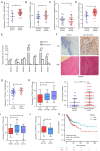
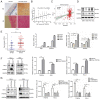
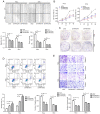

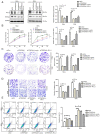
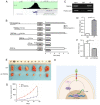
Similar articles
-
MiR-204-5p/TFAP2A feedback loop positively regulates the proliferation, migration, invasion and EMT process in cervical cancer.Cancer Biomark. 2020;28(3):381-390. doi: 10.3233/CBM-191064. Cancer Biomark. 2020. PMID: 32474464
-
RELA promotes the progression of oral squamous cell carcinoma via TFAP2A-Wnt/β-catenin signaling.Mol Carcinog. 2023 May;62(5):641-651. doi: 10.1002/mc.23512. Epub 2023 Feb 15. Mol Carcinog. 2023. PMID: 36789977
-
TFAP2A-induced SLC2A1-AS1 promotes cancer cell proliferation.Biol Chem. 2021 Feb 19;402(6):717-727. doi: 10.1515/hsz-2020-0290. Print 2021 May 26. Biol Chem. 2021. PMID: 33580997
-
The oncogenic role of TFAP2A in bladder urothelial carcinoma via a novel long noncoding RNA TPRG1-AS1/DNMT3A/CRTAC1 axis.Cell Signal. 2023 Feb;102:110527. doi: 10.1016/j.cellsig.2022.110527. Epub 2022 Nov 21. Cell Signal. 2023. PMID: 36410635
-
Zinc-finger protein 471 suppresses gastric cancer through transcriptionally repressing downstream oncogenic PLS3 and TFAP2A.Oncogene. 2018 Jun;37(26):3601-3616. doi: 10.1038/s41388-018-0220-5. Epub 2018 Apr 3. Oncogene. 2018. PMID: 29610526 Free PMC article.
Cited by
-
The potential role of HPV oncoproteins in the PD-L1/PD-1 pathway in cervical cancer: new perspectives on cervical cancer immunotherapy.Front Oncol. 2024 Dec 13;14:1488730. doi: 10.3389/fonc.2024.1488730. eCollection 2024. Front Oncol. 2024. PMID: 39735605 Free PMC article. Review.
-
Integrated bioinformatics combined with machine learning to analyze shared biomarkers and pathways in psoriasis and cervical squamous cell carcinoma.Front Immunol. 2024 May 28;15:1351908. doi: 10.3389/fimmu.2024.1351908. eCollection 2024. Front Immunol. 2024. PMID: 38863714 Free PMC article.
-
Immunomodulatory Effects of SPHK1 and Its Interaction with TFAP2A in Yellow Drum (Nibea albiflora).Int J Mol Sci. 2024 Dec 20;25(24):13641. doi: 10.3390/ijms252413641. Int J Mol Sci. 2024. PMID: 39769404 Free PMC article.
-
The effect of TFAP2A/ANXA8 axis on ferroptosis of cervical squamous cell carcinoma (CESC) in vitro.Cytotechnology. 2024 Aug;76(4):403-414. doi: 10.1007/s10616-024-00619-0. Epub 2024 Apr 8. Cytotechnology. 2024. PMID: 38933875 Free PMC article.
-
TFAP2A Activates S100A2 to Mediate Glutamine Metabolism and Promote Lung Adenocarcinoma Metastasis.Clin Respir J. 2024 Aug;18(8):e13825. doi: 10.1111/crj.13825. Clin Respir J. 2024. PMID: 39187936 Free PMC article.
References
-
- Martínez-Rodríguez F, Limones-González JE, Mendoza-Almanza B, Esparza-Ibarra EL, Gallegos-Flores PI, Ayala-Luján JL, Ayala-Luján JL, Godina-González S, Salinas E, Mendoza-Almanza G. Understanding cervical cancer through proteomics. Cells. 2021;10:1854. doi: 10.3390/cells10081854. - DOI - PMC - PubMed
-
- Yamashita H, Kawasawa YI, Shuman L, Zheng Z, Tran T, Walter V, Warrick JI, Chen G, Al-Ahmadie H, Kaag M, et al. Repression of transcription factor AP-2 alpha by PPARγ reveals a novel transcriptional circuit in basal-squamous bladder cancer. Oncogenesis. 2019;8:69. doi: 10.1038/s41389-019-0178-3. - DOI - PMC - PubMed
MeSH terms
Substances
LinkOut - more resources
Full Text Sources
Medical
Research Materials

